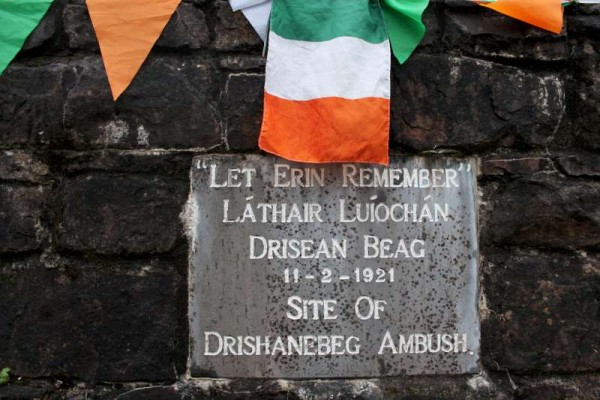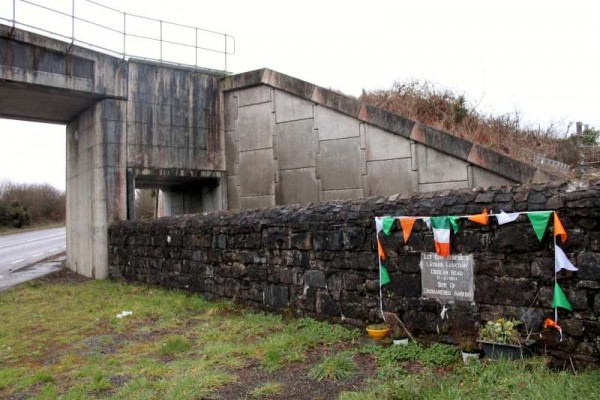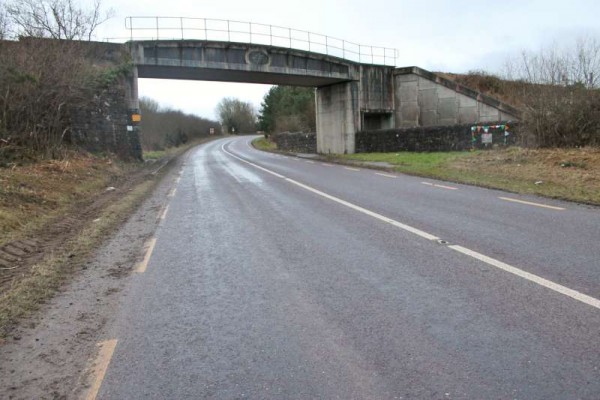The plaque at the Railway Arch, Drishanebeg commemorates the train ambush of 11 February, 1921. Pictured below yesterday, Sunday 20th September, members of the Millstreet Monument Committee marked out the ground for the proposed refurbishment of the plaque. L-R: Andrias Moynihan, Tom Meaney, Jerry Lehane (Chairman), Connie Foley, and Gerdie Buckley. Photo thanks to Tom of TMC Photography.
 Read our more about the Drishanebeg Ambush
Read our more about the Drishanebeg Ambush
Tag: Drishanebeg Ambush
Remembering 1921 Drishanebeg Ambush
The Drishanebeg Train Ambush
In late 1920 Millstreet I.R.A. were considering the viability of an attack being made on British troops who frequently used rail transport while travelling through their battalion area. Various plans were made and men were put in position on a number of occasions during January 1921, but for various reasons a projected attack failed to materialise. Subsequently the column, under Commandant Jeremiah Crowley, re-examined the feasibility of the proposals.
The essential features for the success of any such attack were that the train containing the troops should be brought to a halt at a point where the column was already in a position, that an attack should be made only on an occasion when the troops travelling were armed, and where the party was neither too small to be worth while or too large to risk the failure of the operation. There was the further point that civilian passengers on the train had to be protected as far as possible from injuries. Trains travelling east or west were both potential targets. A position was selected at Drishanebeg about a mile west of Rathcoole station [a], between Millstreet and Banteer. On a few occasions the trains were allowed to pass unmolested, because the soldiers they carried were unarmed, but finally on the evening of 11 February, 1921 the attack came off.
About 6.30 p.m. when it was nearly dark the column went into position. The plan which had been made for bringing the train to a halt came into operation. One of the volunteers, whose duty it was to inspect the train and board it if it contained a suitable party of British forces, this evening saw that the party of troops travelling was such as could be dealt with by the column. He boarded the train and travelled to Rathcoole where two armed Volunteers were waiting. At his signal they boarded the engine as the train was leaving the station and on arrival at the ambush position forced the driver to halt the train. A long whistle blast was blown as a pre-arranged signal to the attacking party. A lighted bicycle-lamp placed on the track indicated the exact position at which the engine should stop.
The Column Commander called upon the military in the train to surrender but was answered by rifle shots. Fire was then opened upon the carriages containing the military party and the battle continued for about fifteen minutes. The slopes of the cutting were lit by oil torches prepared in advanced by the column and thrown down outside the target carriages at the beginning of the encounter. The fight was one-sided from the start, the attackers having the advantage of cover and darkness. When the British surrendered one had been killed and most of the others were wounded.
The column members collected fifteen rifles and a large quantity of ammunition and withdrew from the scene without suffering a single casualty. – Cork’s War of Independence
[a] “Drishanebeg about a mile west of Rathcoole station” This should probably read a mile east of Millstreet Station.





